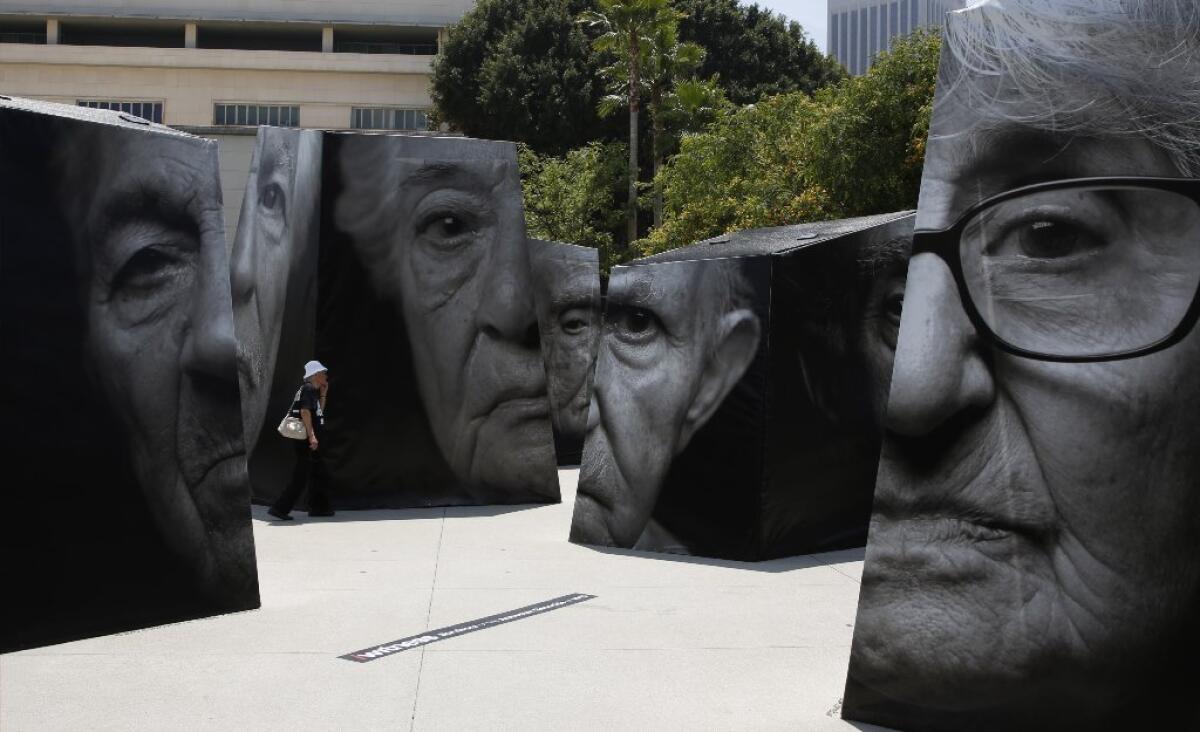Armenian genocide survivors are subject of art exhibit in Grand Park

A woman walks through a portion of “iwitness,” the first public art installation in Grand Park , featuring large-scale photographic sculptures bearing portraits of Armenian Genocide survivors and their stories.
- Share via
Vahida Dekmejian didn’t want to remember. Living in her garage apartment in Pasadena, she preferred to cook. Lahmacun -- Armenian pizza -- was one of her specialties. She taught the recipe to her children and left the remembering to them.
“Unless asked, she didn’t like to open up,” said her granddaughter Paulette Geragos. “It was a brutal story. She saw a lot of violent death.”
------------
FOR THE RECORD:
Grand Park exhibit: In the May 31 California section, an article about a photo exhibit of survivors of the Armenian genocide referred to the height of the sculptures on which the photos were mounted as nearly 7 feet. They range in height from 8 to 15 feet.
------------
Sitting on a bench in downtown’s Grand Park, Geragos looked across the terrace at a large portrait of Dekmejian, one of 45 black-and-white photographs on display through Sunday, each a survivor of the Armenian genocide.
“There is a lot of determination in her eyes,” said Geragos, “as well as melancholy.”
The exhibit, the first outdoor art installation in Grand Park, was created by Ara Oshagan and Levon Parian, who for 20 years have been taking photographs and collecting the stories of Armenian survivors. The project, iwitness, opened last month to commemorate the 100th anniversary of the genocide.
Tightly cropped and brightly lit but for a black background, the portraits gazed out at Saturday visitors: families, picnickers, children splashing in the fountain.
Geragos, 52, was joined Saturday by her parents and other family members for a photograph of three generations to be taken with her beloved medz mayr, who died in 2005 at 103.
Born in Aintab in the Ottoman Empire, Dekmejian saw the deportations, the hunger and murder wrecked upon Armenians by the Ottoman Turkish government in 1915. She was 13 at the time.
After 1915, Dekmejian moved to Aleppo in modern-day Syria, where she made sure that her family left the Middle East and moved to the United States. She emigrated in the 1950s.
“She never said, ‘Never forget,’” Geragos recounted. “She never asked us to carry on her legacy. It was implicit.”
The expression of the other survivors -- like Dekmejian’s, neither recriminating nor judgmental -- convey a solemn dignity despite what they saw and experienced in their childhood.
Mounted on trapezoidal prisms nearly 7-feet tall, their faces are etched by time: hair gray and wispy, eyes clouded by cataracts, the stubble of beards, the elegance of an earring.
Names are marked by the year and the place of their birth. Phrases from their lives are printed beside them.
Sandstorms uncovered bones everywhere in Meskeneh where thousands of Armenians were buried.
The last thing my father did was to give my mother his pocket watch.
The idea for the project came to Oshagan after attending an event for the 80th anniversary of the genocide.
“There were 80 survivors there,” he said, “and I remember thinking, they’re so fragile. Tomorrow they’re going to disappear.”
Oshagan and Parian began photographing and collecting the oral histories of these men and women, who seldom took the time to recount their experiences.
Speaking to the Times in 1999, Parian said the survivors they met had gotten on with their lives, raising children and making good in their new countries.
“But the guilt of it, the unfinished sorrows,” he added, “are a huge wound opened in the Armenian psyche, and its far from healed.”
Three years ago, Oshagan and Parian conceived of this installation, these large prisms with faces wrapping the corners and no right angles. Its structural design was meant to convey that the world is out of balance, Oshagan said.
“They are transferring what they witnessed to us,” he added. “We’ve become the next generation to remember.”
As Oshagan and Parian photographed gathering families -- and took a group portrait of all the families who had come out Saturday to stand beside the portraits of their parent, grandparent, great-grandparent -- they talked about the prospect of taking the installation to San Francisco, Sacramento, New York, Paris and even Istanbul.
“Can you imagine that?” Oshagan said. “Twenty years ago this would have been completely out of the question.”
Twitter: @tcurwen
More to Read
Sign up for Essential California
The most important California stories and recommendations in your inbox every morning.
You may occasionally receive promotional content from the Los Angeles Times.














